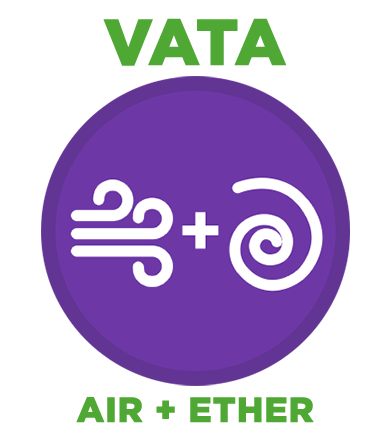Ayurveda is a natural system of medicine that originated in India more than 5,000 years ago. The term Ayurveda is derived from the Sanskrit words ayur (life) and Veda (science or knowledge). Thus, Ayurveda translates to Knowledge of Life or The Science of Life.
Ayurveda is built around the five elements ether, air, fire, water, and earth. The unique combination of these elements makes up the doshas—the constitutions of vata, pitta, and kapha.
The test identifies your predominant dosha and calculates the proportion of the 5 elements present in your dosha constitution.
- VATA (air + ether)
- PITTA (fire + water)
- KAPHA (water + land)
According to Ayurveda, it is the main tool to know our nature, and thus be able to choose the right foods and lifestyle for each person, creating a much more harmonious lifestyle in balance between the mind, body, and our environment.
It is equally important to understand that the doshas within any person keep constantly changing due to their dosha qualities), the specific lifestyle and environment of the person, the time, and the season. Remember that these three are not separate energies but different aspects of the same energy, present in infinite combinations.
When the doshas are in balance, i.e., in a state of equilibrium, we remain healthy.
 Composed of
Composed of ether and air
Means: "that which moves things"
Qualities: dry, light, cold, rough, hard, subtle, clear, mobile
Site in body colon, thighs, hips, ears, bones, and organs of touch
How to Balance Vata
- Favor foods that are warm, moist, and cooked.
- Favor sweet, sour, and salty tastes.
- Massage yourself daily with vata-balancing oil, sesame oil, or almond oil.
- Establish consistent daily routines, including regular meals, exercise, meditation, and sleep/wake times.
- Avoid erratic schedules, stimulants, cold and dry conditions, too much travel, and too much sensory stimulation from smartphones, television, and tablets.
In Ayurveda, Vata Dosha is comprised of air and ether. Spring and fall are the vata seasons, characterized by dryness, mobility, lightness, and coolness. If our constitution and/or our lifestyle mirror these qualities, we risk depleting our ojas—our "fluid of life." But if we introduce the opposing qualities, we can enhance our ojas. Think nourishing, warm, grounding practices.
Here are some simple tips to support balance during vata seasons or if you tend toward vata at any time of the year.
- Choose grounding foods such as sweet potatoes; moist, warming grains and soups; organic oils and ghee; and natural, high-quality sweeteners (i.e., maple syrup or raw honey).
- Integrate warming and carminative (gas-relieving) spices (such as cinnamon, cumin, ginger, salt, cloves, mustard seed, black pepper, cardamom, and basil) into your cooking.
- Avoid dry, raw, and undercooked foods.
- Practice waking up at sunrise and going to bed at the same time every night, maintaining eight hours of restful sleep.
- Do self-massage daily with warm sesame oil, paying extra attention to the feet.
- Eat meals at the same time daily. Make lunch your biggest meal and dinner your smallest.
- Avoid overstimulation. Take time daily for reflection and stillness.
 Composed of
Composed of fire and water
Means "that which digests things"
Qualities oily, sharp, penetrating, hot, light, unpleasant odor, spreading, liquid
Site in body small intestine, stomach, sweat, sebaceous glands, blood, lymph, and organs of vision
How to Balance Pitta
- Favor foods that are nourishing, refreshing, and not overheating.
- Favor sweet, bitter, and astringent tastes.
- Keep the body cool as much as possible—avoid overheating.
- Incorporate regular moderate, noncompetitive exercise.
- Avoid stimulants and acidic foods.
- Include meditation, walks in nature, or time for self-reflection and self-care into your daily routine as much as possible.
In the dog days of summer, pitta aggravation is in full force for many of us. The hot, moist/oily, light, spreading, penetrating, and pungent qualities of the summer season have settled into the body and mind for many of us, creating disease. This is especially true if your constitution is primarily Pitta —one of the three Ayurveda Doshas. When pitta is in balance, it can bring about courage, leadership, steady digestion and elimination, a good sense of humor, love, and luminosity.
When not balanced, it can show up as follows:
- Skin irritations: acne, rashes, hives
- Burning or itching sensation of the skin
- Red burning eyes
- Acid indigestion
- Nausea
- Loose stools
- Anger
- Frustration
- Being overly critical
- Irritability
- Impatience
Try the following practices to balance your pitta.
- Avoid the hot sun of midday.
- Take a walk barefoot at dawn in the dewy grass.
- If your skin reacts to heat, apply a thin layer of coconut oil, followed by a lukewarm shower.
- Keep a bottle of rosewater around you to cool the skin and eyes, and spritz your face and skin regularly.
- If you're experiencing acid indigestion, nausea, or loose stools, practice a pitta-pacifying diet. Favor sweet, bitter, and astringent flavors. Foods like fresh green vegetables, basmati rice, coconut water, sweet apples, ripe bananas, watermelon, cucumbers, and cilantro are all terrific for cooling the hot belly.
- Avoid pungent, salty, and sour foods, as well as overly salty, oily, fried, and spicy foods, including onions, garlic, processed, and canned foods. Also, avoid all alcohol and coffee, especially if your skin is irritated.
 Composed of
Composed of earth and water
Means "that which holds things together"
Qualities cold, wet, heavy, dull, sticky, soft, steady, solid, smooth
Site in body chest, lungs, throat, head, sides, pancreas, stomach, lymph, and fat
How to Balance Kapha
- Favor foods that are light, warm, and cooked.
- Favor pungent, bitter, and astringent tastes.
- Incorporate exercise into your daily routine.
- Vary your routine from time to time.
- Wake up at or before sunrise.
- Avoid napping during the day.
- Eat more lightly in the morning and the evening, with your biggest meal at lunchtime.
Kapha dosha, a combination of the elements of earth and water, rules the springtime. The main seat of kapha in the body is in the chest and lungs, and the qualities of kapha are heavy, slow, dense, dull, soft, oily, and cold.
Now that spring is upon us, we may begin to see excess kapha showing up in the form of mucus in the lungs, lethargy and sleepiness, weight gain, slow digestion, and low energy. Practicing exercise or some asanas/yoga during the kapha times of day (6:00–10:00 am and 6:00–10:00 pm) and practicing more vigorously in a warm space can help alleviate excess kapha.


